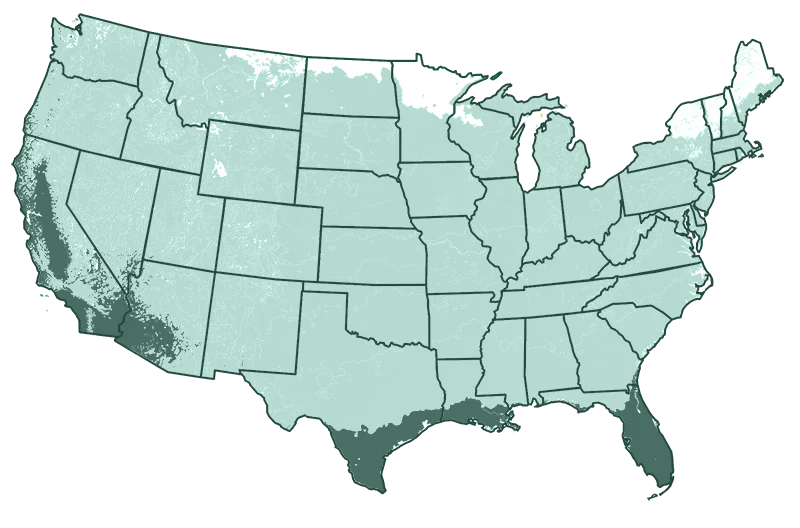You are in GrowingZone 6
Arabica Coffee Plant
View More Planting Info
Choose an area with morning sun and dappled shade in the afternoons. While it’s called a coffee “tree”, this shrub-like plant is grown under the canopy of larger trees in its native environment. Dig a hole twice the width of the plant’s root ball. Prepare the dug-out soil with plenty of compost and peat moss and ensure it is well-draining. Remove the plant from the container and gently tease the roots to open them up. Make sure to plant at the same depth as it was originally planted, no deeper. Plant the coffee plant, backfilling as you go, and finish off by pressing the soil down well, watering, and adding a layer of organic mulch, keeping the mulch away from the tree's trunk (at least 6-8 inches). For containers, ensure the potting soil is enriched with compost and the container has plenty of drainage holes.
Harvesting:
Harvest when coffee cherries change from green to deep red at the end of fall and into winter.
Pruning:
Prune to keep the plants compact for harvest. Remove crossed branches and dead or diseased limbs.
Growth:
Arabica coffee can reach a height of 6 feet and a width of 3 feet. Space 8 feet apart from other plants.
- Product Info
- Care and Maintenance
- Planting Care
- Growing Zone
Product Info
Mature Height: 6 ft.
Mature Width: 3 ft.
Sunlight: Full-Part Sun
Growth Rate: Moderate
Does Not Ship To: AZ, OR
Care and Maintenance
Watering: Coffee plants need constant monitoring for moisture levels. They like to be well-hydrated but not waterlogged. Don’t allow the soil to dry out between watering. They need water to set flowers in the spring and right through to autumn to set fruit. Reduce watering in winter. For container plants, more watering may be necessary. Test the soil moisture level every 2-3 days to make sure they have enough water.
Fertilizing: In summer, feed every two months with a balanced slow-release fertilizer. Choose a product with added minerals such as zinc, iron, boron, and magnesium. Look out for yellowing leaves, a sign of an iron deficiency, and treat with chelated iron or a product formulated for chlorosis.
Pruning: Prune after the red ‘cherries’ have been harvested to keep the plants neat and ensure enough airflow between the lateral branches. Remove any diseased or dying branches.
Pests and Diseases: The caffeine in coffee makes it less likely to be attacked by pests, but monitor for common pests like aphids, spider mites, and mealybugs. Treat them with insecticidal soap or neem oil. Overwatering can cause root rot in soil that is not well-draining.
Pollination: Arabica is self-pollinating. The main pollinators are bees, followed by wasps, butterflies, moths, and sunbirds.
Harvesting: Harvest the coffee cherries when they change from green to a deep red at the end of fall and into winter.
Recovery Time: Transitioning from our nursery to your home can be a bit of a shock to your plant. A short acclimation period helps it recover and reduces stress.
Climate Adjustment: Every environment is unique. Giving your plant time to adjust to the local climate, humidity, and light conditions in a shady spot will set it up for better growth and health.
How to Acclimate Your Plant: Keep the plant in its container and place it in a shady, sheltered area away from high winds. Ensure it's watered adequately – the soil should be moist but not waterlogged. Monitor the plant for any signs of distress and allow it to adjust for a few days before planting. After a few days of acclimation, your plant will be better prepared to thrive in its new home for years to come.
Planting Care
Sunlight: Naturally, they grow under the canopy of trees in tropical forests. The best lighting outdoors is dappled shade. Morning sun and afternoon shade are also suitable.
Soil: Plant in rich, loamy soil with plenty of nutrients. Apply organic mulch to retain moisture and boost nutrients. The soil must be well-draining.
Mature size: Arabica coffee can reach a height of 6 feet and a width of 3 feet. Many coffee growers reduce the height by pruning to harvest the cherries easily. Indoor plants can also be trimmed to keep their height low.
Climate: They prefer a tropical environment and will grow best in altitudes 2600 to 6500 feet above sea level.
Thinning: The main horizontal branches need to be set at even heights between branches. Trim any crossing or dense branches when pruning after harvesting.
Location: Choose a location with morning sun and afternoon shade or an area with constant dappled shade. Avoid full sun, as this will scorch the leaves.
Watering: Keep the soil evenly moist from spring through to fall. They require water to set flowers and fruit.
Pruning: Prune to keep the plants short enough to harvest the fruit. Ensure there are no crossed branches and dead or diseased limbs.
Spacing: Plant coffee plants 8 feet apart from each other and any other plants or structures in the garden. You need more than one coffee tree to grow for harvesting.
Harvesting: Harvesting takes place in late fall and early winter when the berries, called ‘cherries’, are dark red to maroon in color. The cherries are picked by hand at their best.
Pollination: Arabica is self-pollinating. Shake indoor plants when they are in flower to assist pollination.
Hardiness Zone: Arabica Coffee Plants grow outdoors in USDA Zones 9-11. Elsewhere, grow indoors in containers, sheltered in a greenhouse, or protected with fleece fabric in temperatures below 40°F (4°C).
Fertilizer: Feed every second month with a balanced fertilizer with added minerals like boron, magnesium, zinc, and iron.
Growing Zone
Grows Well In Zones: 4-11 patio / 9-11 outdoors










